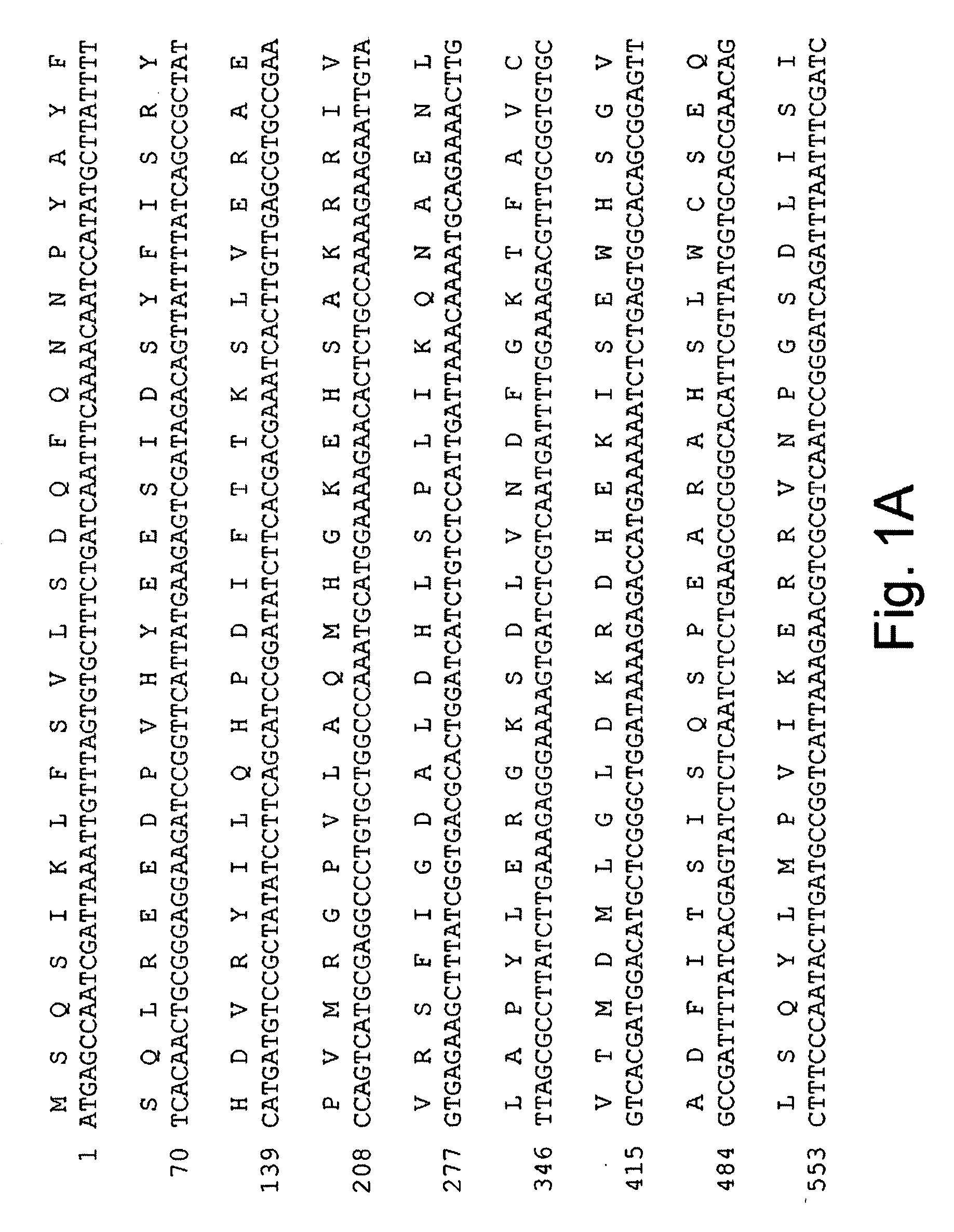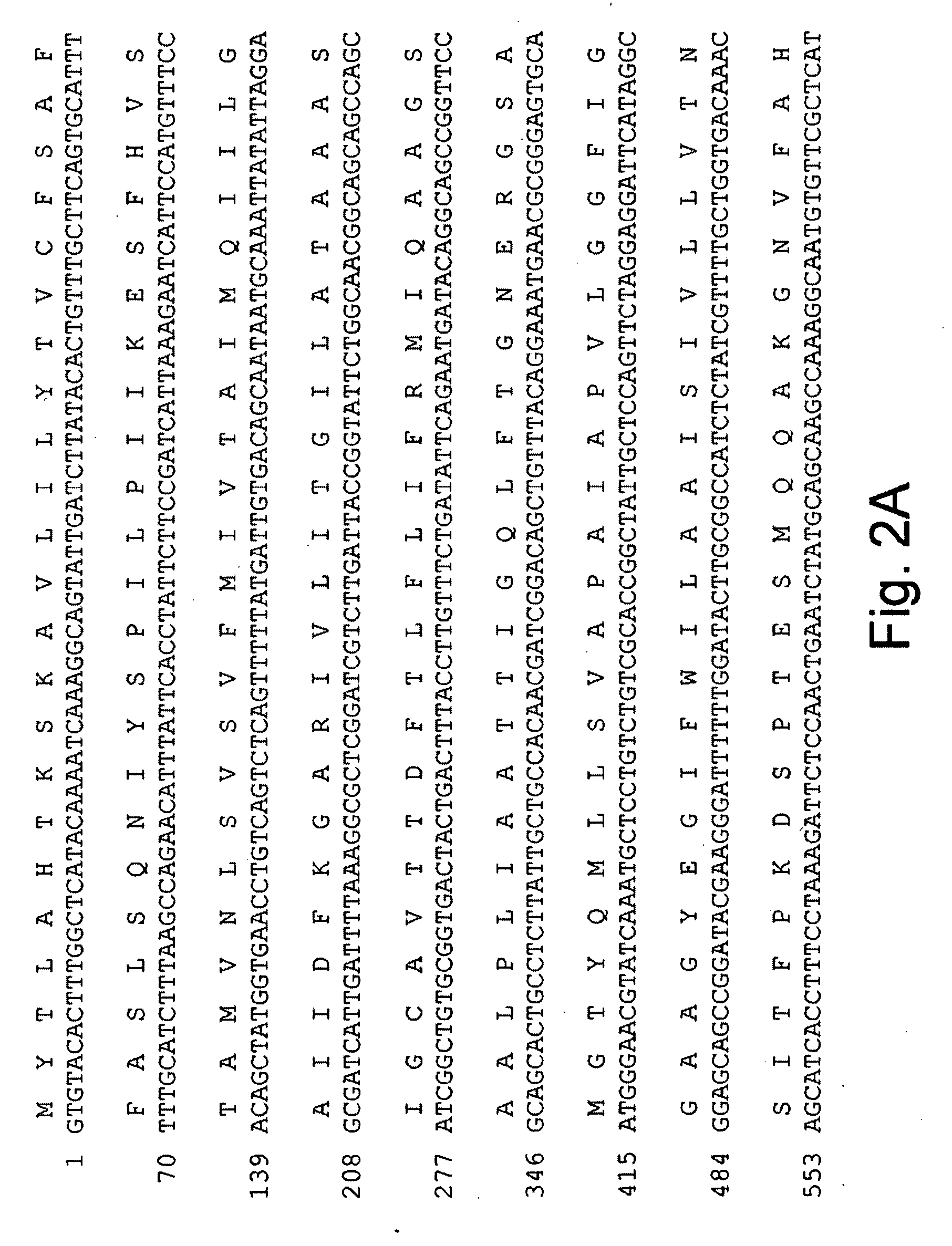Methods for producing biological substances in pigment-deficient mutants of bacillus cells
a technology of bacillus cells and mutants, which is applied in the field of producing heterologous biological substances in pigmentdeficient bacillus mutant cells, can solve the problems that the bacillus host with the desirable traits of increased protein expression and secretion may not necessarily have the most desirable characteristics for successful fermentation, recovery and purification of biological substances produced by the cell, and the process may not be optimal, so as to achieve less red pigment, facilitate recovery and purification, and eliminate red pigmen
- Summary
- Abstract
- Description
- Claims
- Application Information
AI Technical Summary
Benefits of technology
Problems solved by technology
Method used
Image
Examples
example 1
Identification of the cypX-yvmC and yvmB-yvmA Operons Using DNA Microarrays
[0088]Bacillus subtilis strain RB128 is a Bacillus subtilis A164Δ5 strain (Bacillus subtilis ATCC 6051A deleted at the spollAC, aprE, nprE, amyE, and srfC genes) obtained according to the methods of U.S. Pat. No. 5,891,701. Bacillus subtilis strain RB128 contains a heterologous gene encoding a Bacillus maltogenic amylase. Bacillus subtilis strain BRG1 was obtained by N-methyl-N′-nitrosoguanidine (NTG) mutagenesis of Bacillus subtilis RB128 according to the following protocol. Bacillus subtilis RB128 cells grown to log phase were treated with three concentrations of N-methyl-N′-nitrosoguanidine (NTG): 0.26 mg / ml, 0.53 mg / ml, and 1.06 mg / ml yielding percent kills of 98.2%, 99.5%, and 99.9%, respectively. One hundred microliters of each treatment was outgrown 6 times in 1 ml aliquots in 24 well plates. The outgrowths were preserved in 10% glycerol and frozen at −80° C. The library size was approximately 15500, 4...
example 2
Construction of Bacillus subtilis Strain MaTa17
[0092]The cypX-yvmC and yvmB-yvmA operons were PCR amplified from Bacillus subtilis strain BRG1 as a single fragment using primers 1 and 2.
Primer 1:5′-CATGGGAGAGACCTTTGG-3′(SEQ ID NO: 9)Primer 2:5′-GTCGGTCTTCCATTTGC-3′(SEQ ID NO: 10)
[0093]The amplification reactions (50 μl) were composed of 200 ng of Bacillus subtilis BRG1 chromosomal DNA, 0.4 μM each of primers 1 and 2,200 μM each of dATP, dCTP, dGTP, and dTTP, 1× Expand™ High Fidelity buffer with 1.5 mM MgCl2, and 2.6 units of Expand™ High Fidelity PCR System enzyme mix (Roche Diagnostic Corporation, Indianapolis, Ind.). Bacillus subtilis BRG1 chromosomal DNA was obtained using a QIAGEN tip-20 column (QIAGEN, Inc., Valencia, Calif.) according to the manufacturers instructions (Genomic DNA Handbook, QIAGEN, Inc., Valencia, Calif., 1999-2001, pp. 3847). Amplification reactions were performed in a RoboCycler 40 thermacycler (Stratagene, Inc. La Jolla, Calif.) programmed for 1 cycle at 95...
example 3
Construction of Bacillus subtilis Strain A164Δ5ΔcypX
[0098]In order to verify the role the cypX gene plays in the synthesis of the red pigment, the cypX gene was deleted from Bacillus subtilis A164Δ5 (U.S. Pat. No. 5,891,701). Plasmid pMRT122 (WO 03 / 054163) was used to transform Bacillus subtilis A164Δ5 competent cells. Transformants were selected on TBAB-agar plates supplemented with 1 μg of erythromycin and 25 μg of lincomycin per ml and incubated at 30° C. for 24-48 hours. The deleted cypX gene was introduced into the chromosome of Bacillus subtilis A164Δ5 via Campbell-type integration by incubating a freshly streaked plate of Bacillus subtilis A164Δ5 (pMRT122) cells at 45° C. for 16 hours and selecting for healthy growing colonies resulting in Bacillus subtilis strain A165Δ5::pMRT122. Several of the healthy growing colonies were inoculated into 1 ml of LB broth and incubated at 30° C., 250 rpm overnight. The cultured cells were serially passaged at least three times using 10 μl o...
PUM
| Property | Measurement | Unit |
|---|---|---|
| concentrations | aaaaa | aaaaa |
| concentrations | aaaaa | aaaaa |
| concentrations | aaaaa | aaaaa |
Abstract
Description
Claims
Application Information
 Login to View More
Login to View More - R&D
- Intellectual Property
- Life Sciences
- Materials
- Tech Scout
- Unparalleled Data Quality
- Higher Quality Content
- 60% Fewer Hallucinations
Browse by: Latest US Patents, China's latest patents, Technical Efficacy Thesaurus, Application Domain, Technology Topic, Popular Technical Reports.
© 2025 PatSnap. All rights reserved.Legal|Privacy policy|Modern Slavery Act Transparency Statement|Sitemap|About US| Contact US: help@patsnap.com



